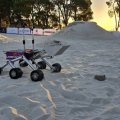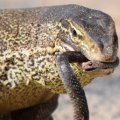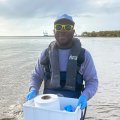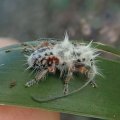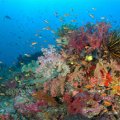
Researchers at UQ's Australian Institute for Bioengineering and Nanotechnology (AIBN) are a step closer to understanding and combating the degenerative brain disease ataxia-telangiectasia.
As part of a collaborative project, Associate Professor Ernst Wolvetang’s AIBN research group has reprogrammed, for the first time, skin cells from people with the disease so they can study the effectiveness of potential treatments.
The collaborators are from the Queensland Institute of Medical Research (QIMR) and The University of Queensland’s Centre for Clinical Research (UQCCR) led by Professor Martin Lavin.
The reprogramming involves taking skin cells, generating pluripotent stem cells and turning them into brain cells for study in the lab.
People with ataxia-telangiectasia develop cancer and brain degeneration because a gene that recognises and repairs DNA damage is defective.
Associate Professor Wolvetang said the ability to reprogram skin cells from children with ataxia-telangiectasia provided a renewable resource to study the neurodegeneration and find medicines to combat it.
“The next step is to correct the genetic mutations in the induced pluripotent stem cellsfrom these patients and then turn these corrected stem cells into brain and blood cells and demonstrate these can replace the defective cells that cause the problems in this disease,” Associate Professor Wolvetang said.
“Delivery of such corrected cells, which is still some years away, or novel drugs discovered using the cells generated in this study may help in treating this disease.”
The researchers could start screening medicines in one to two years, but testing in animals would have to be completed before they could be used in humans.
Professor Lavin said the research had benefited from combining his QIMR and UQCCR research group’s expertise with that of Associate Professor Wolvetang’s AIBN group.
“Joint PhD student Sam Nayler,the support of the patient advocate group BrAshAT, the National Health and Medical Research Council (NHMRC) and a private donor have been instrumental in the success of the project,” Professor Lavin said.
Ataxia-telangiectasia is a rare, inherited disease causing severe disability, including difficulty with movement and coordination, a weakened immune system, a predisposition to infection and a increasing the risk of cancer.
It affects between one in 100,000 and one in 300,000 people.
Patients are frequently in a wheelchair by their early teens and it is generally fatal by the time they reach their twenties.
“I have met patients and their families,” Associate Professor Wolvetang said.
“Witnessing the determination of the children to live life to the full and the heartache borne by their parents, it is self-evident that every effort must be expended to treat these rare diseases.”
The establishment of an Ataxia-telangiectasia Clinic by Dr Kate Sinclair and colleagues at the Royal Children’s Hospital and UQCCR has been a great benefit to patient management and for the conduct of these studies.
Details of the skin cell reprogramming from ataxia telangiectasia patients have been published in the journal Stem Cells Translational Medicine. View the online publication at http://stemcellstm.alphamedpress.org/content/early/recent
Media: Erik de Wit (0427 281 466, 3346 3962 or e.dewit@uq.edu.au)



